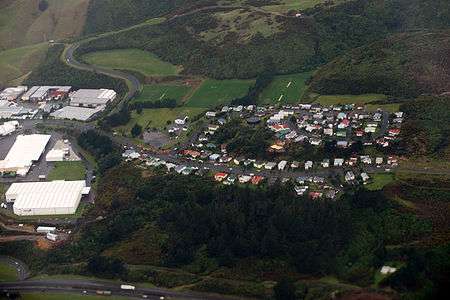Grenada North
| Grenada North | |
|---|---|
 Grenada North | |
| Basic information | |
| Local authority | Wellington City |
| Electoral ward | Northern |
| Coordinates | 41°11′28″S 174°50′44″E / 41.191056°S 174.845438°ECoordinates: 41°11′28″S 174°50′44″E / 41.191056°S 174.845438°E |
| Population | 336[1] (2006) |
| Postcode(s) | 5028[2] |
| Surrounds | |
| North | Takapu Valley |
| East | Horokiwi |
| South | Grenada |
| Southwest | Glenside |
| Northwest | Tawa |
Grenada North is a small suburb in northern Wellington, New Zealand. It is 5 km south of Porirua's city centre, and 13 km north of Wellington's city centre. As of 2006, it has 336 people in 105 occupied dwellings.[1] Its western boundary is formed by State Highway 1 (SH 1N) and Takapu Rd. The suburb itself was named after Grenada in the Caribbean, and most streets are named after Caribbean islands.
History
The suburb was developed by Glendene Developments Ltd in the 1970s so was originally called Glendene, and was expected to join up soon with the suburb of Grenada further south. To meet increased education demand in the Northern suburbs a new Glendene Secondary School was proposed, but by 1980 it was decided that a new co-ed secondary school was not needed and may never be needed. The 14.5 hectare site with sports fields in Jamaica Drive developed by the government was leased to the Wellington City Council for use as playing fields, [3] and was later (c1989) sold to the council. The residential area south towards Grenada is only now (c2015) being developed.
Demographics
Grenada North is 53% male, and has a younger population than Wellington as a whole, with 3.5% of people 65 or older (compared to 11.5%). It has a larger percentage of minorities than Wellington as a whole: 28% Māori (compared to 13%), 20% Pacific Islanders (compared to 8%), 12% Asians (compared to 8%), and 4% Middle Eastern/Latin American/African (compared to 1%). It is less well-educated than Wellington as a whole, with 34% of people age 15 or older having no formal qualifications (compared to 20%), and 30% having a post-school qualification (compared to 46%).[1]
It has a smaller percentage of office jobs than Wellington as a whole, and a larger percentage of industrial workers such as technicians, trade workers, labourers, and machinery operators. Median income is similar to Wellington as a whole, but more workers are paid in the $30,000-50,000 range (35% compared to 23%), and less are paid more than $50,000 (12% compared to 23%). One-family households are more common (77% compared to 67%) and one-person households are less common (12% compared to 25%). All households own at least one motor vehicle, and about two-thirds own at least two.[1]
Aerial view
-

Commercial and industrial part of Grenada North, in northwest corner, facing southeast
-

Residential part of Grenada North, just south of commercial/industrial part, facing east
References
- 1 2 3 4 "QuickStats About Grenada North". 2006 Census Data. Statistics New Zealand. Retrieved 14 September 2013.
- ↑ "Wellington-Wairarapa Region" (PDF). Postcode Listings - Urban areas. New Zealand Post. 2011. Retrieved 14 September 2013.
- ↑ Evening Post, 18 March 1980 p34